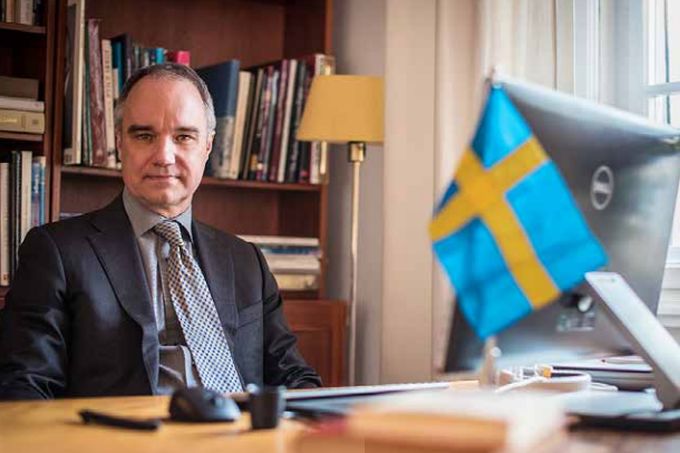
The Kingdom of Sweden has built up a great reputation in the world as a country that pays considerable attention to the preservation of the environment. Innovative and quality solutions for environmental protection are constantly emerging throughout this Scandinavian country and the Swedish government is trying through a series of investments, shares of technology and examples of good practice, to support the developing countries in their endeavor to improve the quality of life. The Kingdom of Sweden donates to Serbia as much as 11 million euros annually, out of which 4 million are invested in the field of environmental protection.
Considering the fact that Sweden has made significant progress in the traffic electrification, we wanted to find out more about the results of the applied methods from Jan Lundin, the Ambassador of Sweden in Serbia.
EP: In Serbia and around the world, Sweden serves as an example of the country with extremely developed ecological awareness. Is the knowledge about the importance of preserving and protecting the environment part of tradition and culture in your country? How is that consciousness being developed?
Jan Lundin: I would not like to guess, but it is a fact that the Swedes got used to living in harmony with nature. We have a lot of forests, a large number of lakes and in general we are rich in water, and we do like to spend time in nature. When it comes to this, I think Sweden does not differ much from Serbia, because there are also many nature lovers here. There is ongoing campaign “Do not litter, you have no excuse!” in Serbian media, and it reminds me of similar activities taking place in Sweden at the beginning 1970’s that drew great attention to the problem of waste management. However, the media campaign is one thing. Although there is no doubt it contributes to raising awareness that people shouldn’t leave trash around, but the level of infrastructure development is completely different thing. If the infrastructure hasn’t been developed, then the campaign doesn’t make any sense. The truth is there are no simple solutions, but the combination of raising awareness activities and good organization provides the proper result.
EP: Among other things, Scandinavian countries are well-known for the everyday use of a bicycle as a means of transport. How come the bike is so popular across Sweden?
Jan Lundin: The Swedes have always been riding bikes. For thirty years, my grandfather used to cover 20 km by bike every day, going to work, and as much on his way back, and he was not the only one. Perhaps one of the reasons for the popularity of bikes in cities and villages across Sweden is actually the fact that our settlements are rather far-flung.
If you visit Serbian village, especially in Vojvodina, you will see that people mainly live in the center, while the farms
are in the surrounding area. On the contrary, houses in Swedish villages are widely distributed with each household situated in the middle of individual property, so the bike was necessary and usual means of transportation until late winter. Back then it was believed that riding a bike is undoubtedly better and healthier habit. Thanks to this attitude, bicycles are still in mass use today throughout the country, even in Stockholm which has developed infrastructure. I am very glad about the progress in the development of bicycle infrastructure that Belgrade has been gradually making, although the local hilliness is surely an aggravating factor.
EP: Do Swedish automobile manufacturers make electromobiles? How is the purchase of an electric vehicle encouraged?
Jan Lundin: There have been attempts to produce electric cars in Sweden, as well as in Norway, but none of the factories prevailed on the market. I suppose it is hard to make money today on electromobiles and only big producers can accomplish that. Even Tesla couldn’t make significant profit for more than ten years since it was founded. We are still waiting for the real breakthrough of electric vehicles, although sales of these cars are growing, primarily in Norway, and to some extent in Sweden. Of the total number of cars in Sweden, currently 3.4 percent are electric-driven and this percentage is constantly increasing. For purchase of an electric vehicle, the states gives a subsidy of about 40,000 Swedish crowns, which is just over 4,000 euros. Although there are incentives for the purchase of electric vehicles, people are reluctant to buy them because they are still very expensive and have no sufficient range to match up to cars on petrol or diesel. In addition, another factor that can affect the efficiency of batteries is Swedish low temperature.
EP: Norway is also a very cold country, and despite of that, it is still an absolute leader in Europe when it comes to the share of electric cars in relation to the total number of vehicles. How do you explain the success of Norwegians in setting up the necessary infrastructure for electric vehicles in such a short time?
Jan Lundin: Norway is somewhat warmer than Sweden, however it is also extremely cold in the north of this country. There are also subsidies in Norway for buying electric vehicles, but I don’t know if they are bigger than those we grant. One should not ignore the fact that in Norway gross national income is about 75,000 euros a year, and in Sweden about 50,000. None of these two countries is poor, but Norway is still considerably richer. A good economic situation is an indispensable condition for the purchase of Tesla, whose models cost about 100 thousand euros.

EP: During 2014 several Swedish companies successfully performed the tests for electric ferries. Are they nowadays in use in public transport along the Channel and Lake Stockholm?
Jan Lundin: It was a pilot project, started partly because of the undeniable advantages of electric maritime transport such are: silence, zero emissions of greenhouse gases, clean air and a quiet ride. Eco-friendly ferries can help us have cleaner cities and water, healthier marine ecosystems, satisfied travelers and lower prices. Several manufacturers were selected, whose ships had a capacity of 70 to 100 passengers and the ability to reduce emissions. This contributed to the reduction of operating costs by 30%. The project was supported by the Swedish Energy Agency and it has been successfully implemented, and now there are plans to gradually increase the number of ferry lines for the transportation of passengers.
EP: Last year Sweden announced the construction of an electric highway – are you familiar with the progress of this project?
Jan Lundin: It is in an experimental phase, which means that only one section which is 2 km long was built in northern Sweden, between Gävle and Sandviken. It is planned that the pilot project lasts for two years, with subsequent aftermath based on the obtained results. The project derived from long-standing cooperation between the Swedish government and the domestic manufacturer of the Scania truck and the German company Siemens. Trucks with batteries that are in use today can’t cover great distances, so on Scania trucks, which are however hybrid vehicles on biodiesel, trolleys are built in and they serve as direct connection to the grid. In Sweden, however, buses and trucks are massively using biodiesel. This is merely one of a great number of pioneering enterprises in our country that gives an opportunity to test different technological solutions. There is an idea to built the distribution network, like rails, into asphalt.
EP: Swedish public companies have recently started the projects of replacing conventional vehicles with electric models, and now this type of vehicle is used by the police. What is the situation with other public services and urban transport?
Jan Lundin: Electric vehicles are in use in a large number of municipalities in Sweden. Our goal is to completely stop using fossil fuels by 2030, and up to this moment we are on the right track. The Swedish police is currently testing electric cars for city driving. A significant share in the total number of electric cars (3.4 percent of the total number of vehicles) are precisely these vehicles used by public services, probably because they have more resources than individuals for their purchase. It’s a shame that we don’t have trolleys – it’s simple technology, old, but functional.
It would be good for trolleys and trams to stay on the rails in your country, but the power they use should not come from fossil fuels. In the long run, coal-related plans have to be changed. Hydroelectric plants like Djerdap don’t pose a problem, nor does solar technology. It has always made me wonder why these sources are not used to a greater extent. Nevertheless, the good news is that Serbia has several solar power plants and furthermore, there are plans to build more plants on solar energy.
A Short Biography of Jan Lundin, the Ambassador of Sweden to Serbia and Montenegro : Lundin got a master degree in law from the University of Stockholm in 1996. Previously he graduated from the University of Uppsala, in the Department of Slavic Languages, Eastern European Studies and Economics. Alongside with his native Swedish, he speaks ten languages fluently, including Serbian, English, German, Russian, French and Italian. Jan Lundin is the Ambassador of Sweden in Serbia since 28 July 2016 which is his third diplomatic mission in our country. Before coming to this position, he was Director General of Permanent International Secretariat of the Council of the Baltic Sea States (CBSS).
Interview by: Nevena Đukić
The interview with the Swedish Ambassador, Jan Lundin, was originally published in the eighth issue of the Energy Portal Bulletin, named EKO-MOBILITY.

